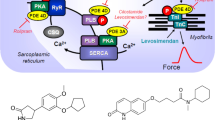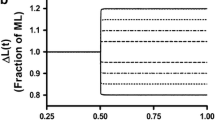Abstract
In guinea-pig papillary muscles the positive inotropic effect of flosequinoxan (BTS) starting at 100 μmol/1 amounted to 287.6 ± 34.2% at 300 μmol/l without any effects on time to peak tension (103.9 ± 2%) and relaxation time (107.1 ± 6.7% of predrug value, respectively). 10 μmol/l carbachol attenuated the positive inotropic effect of 300 μmol/l to 166.5 ± 11.6% (n = 10). The phosphorylation state of the inhibitory subunit of troponin (TnI) and phospholamban(PLB) in [32P]-labeled guinea-pig ventricular myocytes was increased starting at 100 μmol/l amounting to 142.5 ± 12.6% and 130.9 ± 2.2% at 300 μmol/l, respectively (n = 5). Furthermore, BTS (300 μmol/l) decreased phosphorylase phosphatase activity by 23.1%. It is concluded that the contractile effects of BTS are accompanied by enhanced phosphorylation of regulatory proteins which could in part be due to inhibition of phosphorylase phosphatase activity.
Similar content being viewed by others
References
Ahmad Z, Green FJ, Subuhi HS, Watanabe AM (1989) Autonomic regulation of type 1 protein phosphatase in cardiac muscle. J Biol Chem 264:3859–3863
Bodor GS, Porter S, Landt Y, Ladenson JH (1992) Development of monoclonal antibodies for an assay of cardiac troponin-I and preliminary results in suspected cases of myocardial infarction. Clin Chem 38:2203–2214
Bradford MM (1976) A rapid and sensitive method for the quantification of microgram quantities of protein utilizing the principle of protein-dye binding. Anal Biochem 72:248–254
Cowley AJ, Wynne RD, Hampton JR (1984) The effects of BTS 49465 on blood pressure and peripheral arteriolar and venous tone in normal volunteers. J Hypertens 2 [Suppl 3]:S547–549
Falotico R, Haertlein BJ, Lakas-Weiss CS, Salata JJ, Tobia AJ (1989) Positive inotropic and hemodynamic properties of flosequinan, a new vasodilator, and a sulfone metabolite. J Cardiovasc Pharmacol 14:412–418
Feldman AM, Copelas L, Gwathmey JK, Phillips P, Warren SE, Schoen FJ, Grossman W and Morgan JP (1987) Deficient production of cyclic AMP: pharmacologic evidence of an important cause of contractile dysfunction in patients with end-stage heart failure. Circulation 75:331–339
Gottlieb SS, Halpern JL, Kessler PD, Rothlauf E, Packer M (1987) Dissociation of the systemic and regional vascular responses to the vasodilator drug, flosequinan, in heart failure. Circulation 76: [suppl IV] 445 (abstr)
Gristwood RW, Beleta J, Bou J, Cardelús I, Fernández AG, Lleans J, Berga P (1992) Studies on the cardiac actions of flosequinan in vitro. Br J Pharmacol 105:985–991
Gupta RC, Neumann J, Watanabe AM (1993) Comparison of purinergic and musearinic receptor mediated effects on phosphatase inhibitor-1 activity in the heart. J Pharmacol Exp Ther 266:16–22
Jones LR (1985) Sarcolemmal enzymes mediating \-adrenergic effects on the heart. In: Bronner F, Shamoo AE, (eds) Current topics in membranes and transport: regulation of calcium transport across muscle membranes. Academic Press, New York, p. 11–41
Korth M (1978) Effects of several phosphodiesterase inhibitors on guinea-pig myocardium. Naunyn Schmiedeberg's Arch Pharmacol 302:77–86
Neumann J, Gupta RC, Schmitz W, Scholz H, Nairn AC, Watanabe AM (1991) Evidence for isoproterenol-induced phosphorylation of phosphatase inhibitor-1 in the intact heart. Circ Res 69:1450–1457
Neumann J, Boknik P, Herzig S, Schmitz W, Scholz H, Gupta RC, Watanabe AM (1993) Evidence of physiological functions of protein phosphatases in the heart. Evaluation with okadaic acid. Am J Physiol 265:H257-H266
Neumann J, Boknik P, Bodor GS, Jones LR, Schmitz W, Scholz H (1994) Effects of adenosine receptor and muscarinic cholinergic receptor agonists on cardiac protein phosphorylation. Influence of pertussis toxin. J Pharmacol Exp Ther 269:1310–1318
Perreault CI, Hague NL, Loh E, Hunneyball IM, Sim MF, Morgan JP (1992) Differential inotropic effects of flosequinan in ventricular muscle from normal ferrets versus patients with end-stage heart failure. Br J Pharmacol 106:511–516
Rapundalo ST, Solaro RJ, Kranias EG (1989) Inotropic responses to isoproterenol and phosphodiesterase inhibitors in intact guinea-pig hearts: Comparison of cyclic AMP levels and phosphorylation of sarcoplasmic reticulum and myofibrillar proteins. Circ Res 64:104–111
Sakai M, Ohkawa S, Kaku T, Kuboki K, Chida K, Imai T (1993) Pharmacokinetics of flosequinan in elderly patients with chronic congestive heart failure. Eur J Clin Pharmacol 44:387–389
Scholz H, Meyer W (1986) Phosphodiesterase-inhibiting properties of newer inotropic agents. Circulation 73 [Suppl III]:99–108
Sham JSK, Jones LR, Morad M (1991) Phospholamban mediates the \-adrenergic enhanced Ca2+ uptake in mammalian ventricular myocytes. Am J Physiol 261:H1344-H1349
Solaro RJ (1986) Protein phosphorylation and the cardiac myofilaments. In: Solaro RJ (ed) Protein phosphorylation in heart muscle. CRC press, Boca Raton, pp 129–156
Weishaar RE, Wallace AM, Kirker ML, Ferraris VA, Sim MF (1991) Direct effect of flosequinan on the contractility of cardiac muscle fibers from patients with and without heart failure. Circulation 84: [Suppl II] 242 (abstr)
Weishaar RE, Wallace AM, Kiser LM, Ferraris VA, Britton LW, Sim MF (1994) Assessment of flosequinan's direct effect on human arterial, venous, and cardiac muscle: comparison with other classes of agents to treat heart failure. J Cardiovasc Pharmacol 23:792–798
Yates DB (1991) Pharmacology of flosequinan. Am Heart J 121:974–983
Author information
Authors and Affiliations
Rights and permissions
About this article
Cite this article
Zimmermann, N., Bodor, G.S., Boknik, P. et al. Mechanisms of the contractile effects of flosequinoxan. Naunyn-Schmiedeberg's Arch Pharmacol 351, 385–390 (1995). https://doi.org/10.1007/BF00169079
Received:
Accepted:
Issue Date:
DOI: https://doi.org/10.1007/BF00169079




